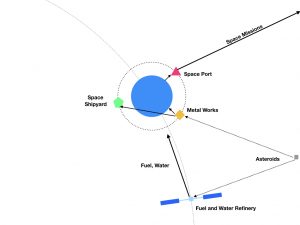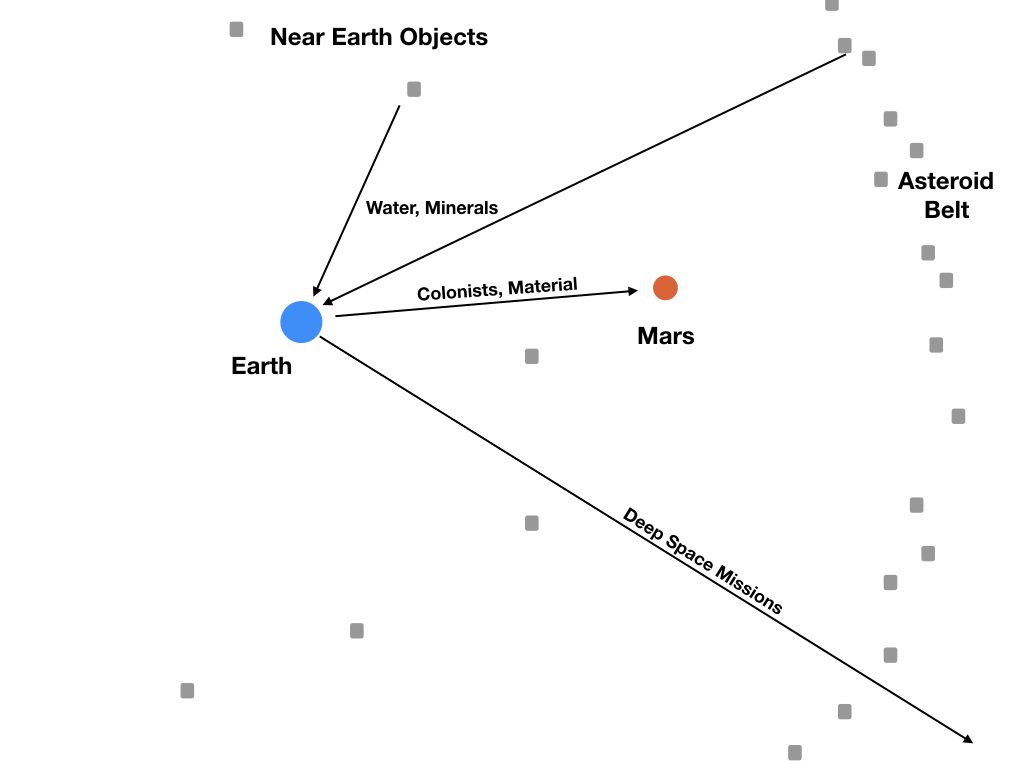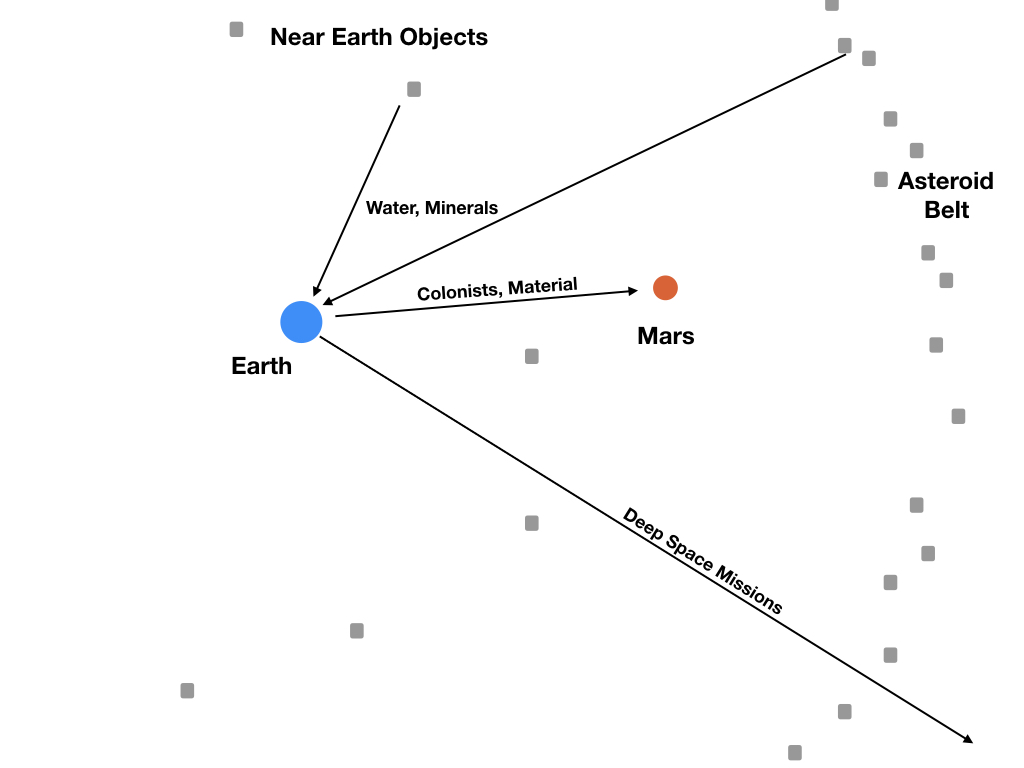The Space Industry
The dream of colonizing Mars has received a new boost with Elon Musk’s plans to bring colonists there within the next few years. He plans to bring all the material and all the fuel from Earth’s surface into an orbit and then start the trip to Mars.
While this might be a viable way to do it, it is not the most sustainable and energy-efficient way. One of the biggest problems in space exploration today is that we have to lift everything that a space mission needs out of Earth’s gravitational pull. This makes space missions both expensive and wasteful.
What if we could cut the need to leave the gravitiational pull out of the equation? It would make space exploration both more efficient and affordable. But how could we do it?
Luckily, we can find many ressources that we need in our solar system. The asteroids in the group of the Near-Earth Objects and in the asteroid belt between Mars and Jupiter seem to contain both water and different types of minerals.
Asteroids are perfect places for harvesting ressources in space. They have a low mass and thus only little gravity. This means space ships can land and take of easily. They might even be pushed further towards Earth to shorten the transporation route.
This is no longer science fiction: A number of businesses like Planetary Ressources plan to harvest these ressources.
Water and Fuel
But just harvesting these ressources is not enough. We have to put them to good use. The first things we need for space exploration is fuel. Luckily, rocket fuel is made of hydrogen and oxygen. Because many asteroids contain water, we can harvest that water to create rocket fuel by electrolysis.
Because electrolysis uses a lot of energy, we need a powerful energy source to perform the electrolysis. The only energy source we have in space is the sun, so a water refining facility in space needs to have huge solar cells to produce the energy we need for the process. This refinery would not be placed in an orbit around Earth, because then it would be in the shadow of Earth almost half of the time. It is much better to place it in an orbit around the sun, trailing Earth so the fuel can be moved more easily to our home planet.
Water is also a vital ingredient for every manned space mission. The fact that we find it in space spares us the need to lift it to the orbit.
Once the refinery is in place, two kinds of tanker ships will fly between the refinery and Earth – water tankers and fuel tankers.
Metal Works
They could dock at a space port, where astronauts and colonists that come from Earth board their ships that are tanked with the fuel and water from the refinery.
With the fuel that we produce at the refinery, we can perform another energy consuming task: The processing of the minerals that we harvest from other asteroids. Refining and melting minerals takes a lot of energy on Earth, and so it will do in space. The rocket fuel with its high energy density will prove vital for the operation of metal works in space.
When we have developed metal production processes that work in space, we could use them to produce the raw materials for our space ships in our orbit. This means we can even build our space ships there. We could make them bigger than possible if we had to lift them from Earth to the orbit.
It would also be possible to bring the refined metals down to Earth. But we would only do it for very rare metals, because landing on Earth is a process that needs a lot of energy to decallerate the space ship.

Transport Between Planets
Once we have this space industry in place, it will enable the exploration and colonisation of the solar system.
To Mars and Back?
With space ships built in orbit, we can build space ships big enough to transport colonists to Mars.
Once they arrive there, they will set up a colony. Because a trip between Earth and Mars takes about two years in optimal conditions, a Mars colony will have to become independent very quickly. Supplies from Earth can only come with a long delay and at relatively high costs.
The colonists will set up their own industry and transportation system, using the ressources they find on the planet to become self-sustainable as fast as possible.
As soon as the goal is reached, the only transport goods between Earth and Mars will be more settlers.
What about the other way round? Mars will not be able to export anything to Earth until it has reached self-sustainability. And even then, everything that is produced on Mars will have to compete with products from Earth or the space industry. So it is not very likely that there will be a flow of goods from Mars to Earth.
Also we should not expect too many people flying back to Earth. For one thing, space travel is both dangerous due to the radiation and it is very tedious – you have to spent two years in a tiny space ship. I guess not many people want to do this multiple times in their lifes. And if somebody who is used to Mars’ low gravity can even walk on Earth is not clear at all.
All in all, the transport to Mars will be a one-way affair. And because Mars is so far away, the colonists there might think after a while that they don’t even belong to Earth anymore and will try to achieve independence. At that moment, it is not clear if they will accept any more settlers from Mother Earth at all or if they will close their borders (but building a wall around Mars might still prove a little too hard, though).
To Infinity and Beyond
Once Mars is self-sustainable, the overall goal of colonizing it is fulfilled: To have a second planet where humanity can live. Even though there might not be much interchange between Earth and Mars afterwards, the space industry can serve other purposes as well.
With all this infrastructure in place, we can intensify the exploration of other planets and moons in our solar system. We might even be able to send a manned ship to the outer or inner planets. After all, with enough rocket fuel we can fly both faster and farther.
We might even be able to send space probes out of our solar system to other stars.

Protecting Earth
Another use of the infrastructure that we put into space is to protect Earth from asteroids that are on a collision course.
The infrastructure can both be used for a better surveillance and for collision avoidance. It is critical to find an asteroid on a collision course as early as possible.
And once we have spotted a potential threat, we need to send a space ship there to alter its course. This will be much easier if we have the infrastructure to build such a space ship in place.
Conclusion
Why, you might say, would we go through all this hassle to build a very expensive infrasctructure just to fly to other planets? We have everything we need here on Earth and don’t need to leave it.
I could cite Elon Musk’s argument that we need a second planet as a backup so that humanity can survive an Earth-wide catastrophe. Or the need to protect Earth from asteroids. But of course, it is not proven that any of these events will ever happen.
So the most compelling argument for me why we should build this infrastructure is this: Because we can imagine it. It is a huge challenge that will inspire generations of engineers, scientists and explorers in the future. It will inspire them to work together, just like we work together nowadays to build and operate the ISS.
And once this infrasctructure is in place, who knows what other things we can do with it. Because infrastructure is what makes useful things possible. And you never quite know what this might be. So let’s try!
